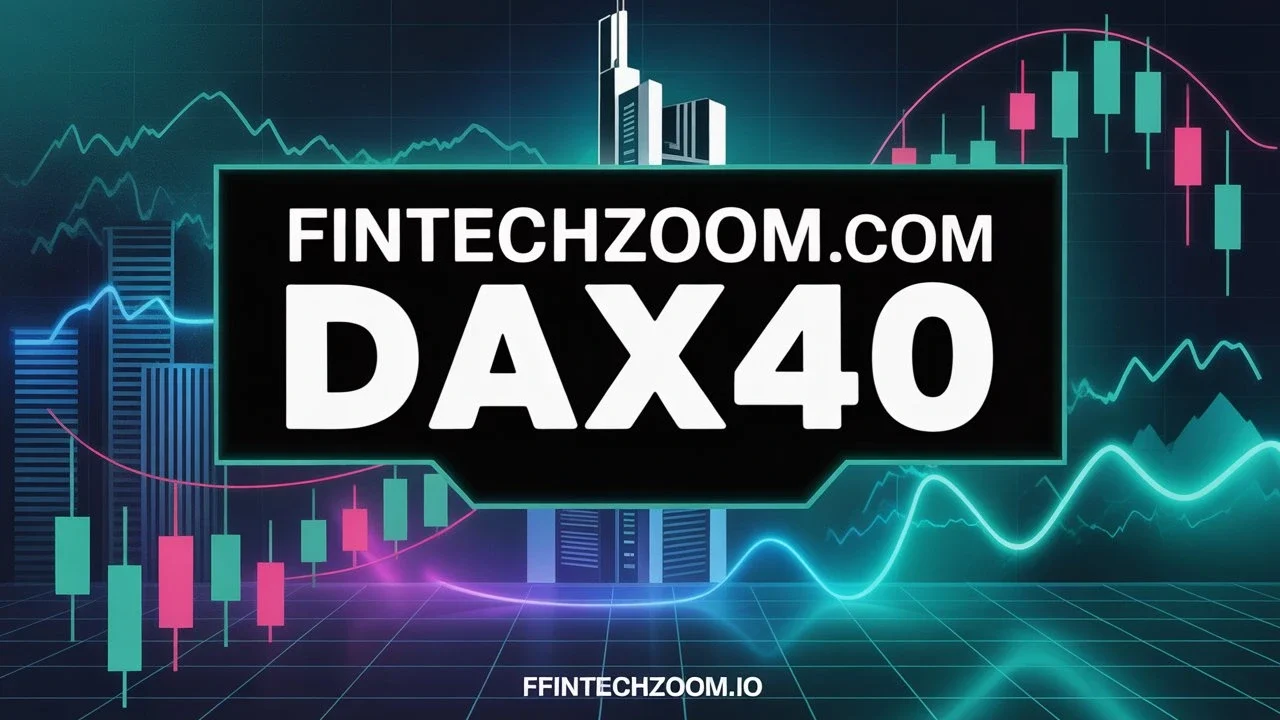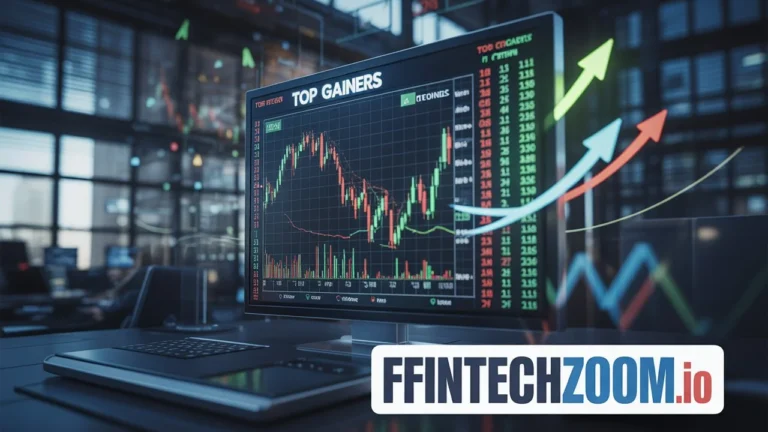Fintechzoom.com DAX40: Germany’s Leading Stock Index

The DAX 40 is a key indicator of the German stock market. It shows the results of 40 major commercial companies listed on the Frankfurt Stock Exchange. These companies include well-known names in the automotive, finance, technology, healthcare, and industrial sectors.
The index was previously known as the DAX 30 until 2021. At the time, he only had 30 companies. In September 2021, the number rose to 40, providing investors with a more comprehensive and stable view of the German economy.
Why is Dax 40 important?
Germany has the largest economy in Europe and is one of the most influential economies in the world.
Many global investors manage the DAX 40 and value the health of the German and European economies. Index growth means that German companies are on the way. If it falls, it could become a more widespread issue.
For international investors, the DAX 40 is like a window into Europe’s financial future.
Fintechzoom.com DAX40 Overview

FintechZoom is a platform that simplifies the process of following and understanding financial markets. It covers global indices, stocks, and significant economic events.
On its DAX40 page, investors can see:
- Real-time prices of the index
- Charts and graphs showing past performance
- News updates about the German economy
- Company breakdowns for all 40 members
The goal is straightforward: to provide traders and investors with the necessary tools to make informed decisions.
For beginners, this means straightforward explanations of how the index works. For professionals, this means utilizing technical analysis tools such as moving averages and trend indicators.
DAX40 Companies List and Sector
The DAX 40 includes companies from various industries. This makes it more balanced compared to when it was the DAX30.
Here is a breakdown of the main sectors represented:
| Sector | Examples of DAX40 Companies | Why It Matters |
|---|---|---|
| Automotive | Volkswagen, BMW, Mercedes-Benz | Germany is the world leader in car exports |
| Pharmaceuticals & Healthcare | Bayer, Merck, Siemens Healthineers | Strong global demand, resilient sector |
| Technology & Software | SAP, Infineon | Growing digital economy |
| Financial Services | Deutsche Bank, Allianz, Munich Re | Key players in global finance |
| Industrials & Chemicals | Siemens, BASF | Backbone of German industry |
| Consumer Goods | Adidas, Zalando | Brands with global reach |
This sector mix makes the DAX40 a diversified index. However, it still has a strong focus on automotive and industrial companies, which reflects Germany’s traditional strengths.
How the DAX40 Index Is Calculated
The DAX40 is calculated using a free-float market capitalization method. This means:
- Only shares that are available for trading in the market are counted (not locked-in or government-owned shares).
- Bigger companies with more market value have more weight in the index.
Unlike many indices, DAX is also a performance index. This means that the calculation includes dividends paid by the company. Therefore, when investing in the DAX 40, the results seen reflect both price changes and dividend reinvestments.
This makes it different from the S&P 500 or FTSE 100, which usually show price returns only.
Latest Trends and Market Performance
As of 2024 and into 2025, the DAX40 has faced both challenges and opportunities:
- Energy airlines have influenced many German companies, as Europe relies on imports.
- High inflation across Europe has led the European Central Bank (ECB) to raise interest rates. This has put pressure on actions, particularly in the banking and real estate sectors.
- DAX 40 technology and renewable energy source companies are demonstrating stability by capturing global demand for pure energy and digitalization.
- The automotive sector is currently undergoing migration. Traditional automakers remain strong, but face significant competition in the electric vehicle market.
Despite volatility, the DAX 40 remains attractive to investors due to Germany’s stable economy and robust export base.
How to Invest in the DAX40 with FintechZoom

There are several ways for investors to gain exposure to the DAX40. FintechZoom helps by showing real-time updates, analysis, and educational resources.
Here are the primary methods:
- Exchange Traded Funds (ETFs)
- Example: ETFs that track the DAX 40 enable investors to purchase the entire index at once.
- Best for beginners who want diversification.
- Futures and Options
- For advanced traders who want to speculate on future prices.
- Can be used to hedge risks.
- Contracts for Difference (CFDs)
- Allows traders to bet on price moves without owning the actual stocks.
- High risk, but flexible.
- Direct Stock Purchase
- Investors can purchase shares of individual companies in the index, such as SAP or Volkswagen.
- Allows more control, but less diversification.
FintechZoom provides the tools to track all these methods and compare strategies.
Trading Strategies for DAX40 Investors
Every investor has different goals. Here are common approaches:
- Long-term property: Many investors view the DAX 40 as an option for “purchasing and holding,” leveraging Germany’s long-term economic strength.
- Swing Trade: Traders target medium-term prices to capitalize on market fluctuations.
- Daytime Trade: Some individuals utilize their daytime cards to achieve success quickly. This requires high skills and strong risk management.
- Sector rotation: Moving money between solid sectors (e.g., technology in one cycle, industry in another).
To succeed, investors need to set clear goals, manage risks effectively, and utilize tools such as stop-loss orders.
Risks and Challenges of Investing in the German DAX40
No investment comes without risk. While the DAX40 is a strong index, investors should keep these points in mind:
- Currency Risk
The DAX40 is priced in euros. For investors outside the eurozone, changes in exchange rates can affect returns. - Sector Concentration
The index is heavily weighted toward the automotive, industrial, and chemical sectors. - Geopolitical Factors
Germany’s economy depends on exports. Global trade tensions, tariffs, or conflicts can hit companies like Volkswagen, BASF, or Siemens. - Energy Dependence
Germany’s reliance on imported energy has been a key issue. - Market Volatility
Economic shocks, central bank decisions, or global crises can cause the DAX 40 to become highly volatile.
Being aware of these risks enables investors to develop more effective strategies.
Comparing DAX40 to Other Major Indices
The DAX 40 is one of the most widely followed indices globally. However, how does it compare to others?
| Index | Region | Companies Count | Main Features |
|---|---|---|---|
| DAX40 | Germany / Europe | 40 | Dividend-inclusive, export-driven, industrial heavy |
| S&P 500 | USA | 500 | Broad, tech-heavy, global benchmark |
| FTSE 100 | UK | 100 | Strong in finance, energy, consumer goods |
| CAC 40 | France | 40 | Mix of luxury, banking, energy |
| Nikkei 225 | Japan | 225 | Price-weighted, tech and industrial focus |
Future Outlook for DAX40 in 2025
Looking ahead, several trends are likely to shape the DAX40:
- Shift to Clean Energy and Sustainability
- Rise of Digitalization
- Automotive Transition
- Global Economic Conditions
- Export Growth
Overall, while short-term volatility is expected to persist, the long-term outlook for the DAX 40 remains strong, given Germany’s role as a global economic powerhouse.
Conclusion
The Dax40 is more than a simple number on the screen. This reflects the power and challenges of the German economy and its global role. From automotive giants to technical leaders, the Index consolidates companies that contribute to Europe’s growth.
For post-DAX 40 investors, it means understanding industry movements, currency fluctuations, and how global trade will impact Germany.
Fintechzoom provides data, understanding, and real-world tools that will drive this trip and simplify your investment solutions. Whether you are a beginner looking to study or an experimental strategy for the construction of traders, Fintechzoom’s DAX40 coverage offers value.
In short, the Fintechzoom.com Dax40 page is not only a list of leading German companies, but also a roadmap for wise investments in Europe.
FAQs
1. What is Fintechzoom.com DAX40?
It is a section on FintechZoom that explains and tracks the DAX40 index, Germany’s top stock market benchmark.
2. How many companies are in the DAX40?
As the name suggests, the index includes 40 of the largest and most traded German companies.
3. Which sectors dominate the DAX40?
The index is strongest in the automotive, industrial, financial, chemical, and technology sectors.
4. How is the DAX40 different from the S&P 500?
The S&P 500 comprises 500 companies from the US and is heavily weighted towards technology. The DAX 40 shall consist of 40 companies from Germany and includes dividends in its calculation.
5. Can beginners invest in the DAX40?
Yes. The easiest way for beginners is through ETFs that track the DAX 40.
6. What affects the price of the DAX40 the most?
- Export demand (especially from Asia)
- Energy prices in Europe
- Interest rate decisions by the ECB
- Global market trends
7. What are the risks of DAX40 investing?
The most significant risks include currency fluctuations, sector concentration, and global trade tensions.
8. How can I track DAX40 performance daily?
Investors can follow it on platforms like FintechZoom, where charts, news updates, and live prices are available.
9. Why did DAX expand from 30 to 40 companies?
The change was made in 2021 to reduce risk, add diversification, and strengthen the index.
10. What is the future outlook for the DAX40?
By 2025 and beyond, the DAX40 is expected to be shaped by green energy, digitalization, and electric vehicles.






